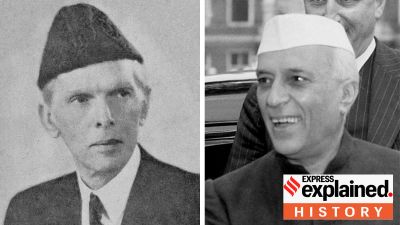
India world’s most populous with 142.86 cr by mid-’23: UN report
Syllabus:
Preliminary Examination: Economic and Social Development
Mains Examination: General Studies I: Population and associated issues
Key Points to Ponder:
• What’s the ongoing story- With its population estimated to touch 142.86 crore by the middle of this year, marginally ahead of China at 142.57 crore, India is on track to be the world’s most populous country, according to the UNFPA’s State of World Population Report 2023 released on Wednesday. According to the report, 68 per cent of India’s total population is between the ages of 15 and 64 years, which is considered the working population of a country. About 25 per cent is between 0-14 years; 18 per cent between 10 and 19 years, 26 percent between 10 and 24 years, and 7 per cent above 65 years.
• UNFPA’s State of World Population Report 2023-what exactly report said?
• World Population Report 2023- What are the main takeaways for the global population?
• Do You Know-Another UN Report, World Population Prospects 2022, that was released in July last year, had said that by 2050, India’s population would reach 166.8 crore, far exceeding China’s declining population at 131.7 crore. In 1950, India was at 86.1 crore, while China was at 114.4 crore. According to the UN projections, India’s population is expected to grow for the next three decades after which it will begin declining. While the global population touched 8 billion last November, the new UNFPA report said it is growing at its slowest rate since 1950, having fallen under 1 per cent in 2020. According to the report, the estimated global population is 8,045 million, of which 65 per cent is between 15-64 years, 24 per cent between 10-24 years, and 10 per cent above 65 years.
• “As the world reaches 8 billion people, we at UNFPA see India’s 1.4 billion people as 1.4 billion opportunities”-How far you agree?
Story continues below this ad
• For Your Information-According to the report, the average life expectancy at birth for males in India is 71 years while for females it is 74 years. India’s total fertility rate (births per woman in the reproductive age) is estimated at 2.0. The report indicates that population anxieties are widespread and governments are increasingly adopting policies aimed at raising, lowering or maintaining fertility rates.
• What is ‘Demographic gravitation’?
• Can you highlight population transformations around the globe?
• In what ways, the COVID-19 pandemic has affected all components of population change, including fertility, mortality and migration?
• How Population data provide critical information for use in development planning?
• What are the factors influencing the population growth?
• Most countries have population policies and programmes to influence fertility levels. What are the policies and programmes in India to influence fertility levels?
• What is Total Fertility Rate (TFR)?
• What does Total Fertility Rate (TFR) of 2.0 mean?
• What is Replacement Fertility Rate?
• How is the Total Fertility Rate calculated?
Story continues below this ad
• What is the difference between birth rate and Total Fertility Rate (TFR)?
• Does an increase in births mean that TFR will go up?
• What is demographic dividend?
• What is the significance of India overtaking China?
• What pattern of population distribution is India?
• What are the policy implications arising out of these two trends?
• How reliable is the UN projection, and how do they compare with India’s Census?
• Family Planning in India-Issues and Challenges
Story continues below this ad
• Population growth brings what sort of challenges for Indian public policy?
• Do you think that massive growth in population in India is blessing in disguise?
Other Important Articles Covering the same topic:
📍Behind population numbers
Data from revamped surveys of household spending may come after 2024 elections
Syllabus:
Preliminary Examination: Current events of national and international importance.
Main Examination: General Studies III: Indian Economy and issues relating to planning, mobilization, of resources, growth, development and employment.
Key Points to Ponder:
Story continues below this ad
• What’s the ongoing story– RESULTS of the revamped Consumer Expenditure Surveys (CES) for 2022-23 and for 2023-24, meant to reveal more granular details of income and spending patterns in rural and urban households, may now come well after the 2024 general elections, The Indian Express has learnt. Although the results of the first survey for 2022-23, which will end in July, are likely to come through by December this year, officials involved in the exercise indicated that it has not yet been decided if these will be released immediately. The second of the two revamped Surveys, for 2023-24, is set to be launched in July this year and a decision on releasing the results of these two Surveys together would mean that it would be pushed back to well beyond the summer of 2024.
• What is the Consumer Expenditure Survey?
• Who conducts Consumer Expenditure Survey?
• The Consumer Expenditure Survey is conducted every five years-True or False?
• The Consumer Expenditure Survey is to collect information on the consumption spending patterns of households across the country, in urban areas-True or False?
• The data gathered in Consumer Expenditure Survey reveals what?
• What is Monthly Per Capita Consumer Expenditure (MPCE)?
• Consumer Expenditure Survey and Monthly Per Capita Consumer Expenditure (MPCE)-Connect the dots
• Why Consumer Expenditure Survey is helpful?
• The revamped Consumer Expenditure Survey includes new features-know them
Story continues below this ad
• Do You Know-The Consumer Expenditure Survey aims at generating estimates of household Monthly Per Capita Consumer Expenditure (MPCE) and the distribution of households and persons over the MPCE range separately for rural and urban sectors across the country and for different socio-economic groups. It is designed to collect information regarding expenditure on consumption of goods and services (food and non-food) consumed by households. The results are then also used for rebasing of the GDP and other macroeconomic indicators such as retail inflation based on the Consumer Price Index (CPI).
Other Important Articles Covering the same topic:
📍New consumer expenditure survey is long overdue. Govt should move to doing surveys on a more regular basis
GOVT & POLITICS
New Cinematograph Bill to check film piracy gets Cabinet approval
Syllabus:
Preliminary Examination: Current events of national and international importance
Main Examination: General Studies III: Issues relating to intellectual property rights.
Key Points to Ponder:
Story continues below this ad
• What’s the ongoing story– With the Union Cabinet giving its approval to the Bill on Wednesday, the Information and Broadcasting (I&B) Ministry is set to bring a fresh legislation with stringent provisions to tackle the menace of piracy in films, which leads to losses worth thousands of crores to the movie industry annually. The Bill will also introduce detailed classification of film content based on age groups, considering the growing content on OTT platforms curated by an expanding industry. I&B Minister Anurag Thakur on Wednesday said the Centre will introduce the Cinematograph Bill, 2023 in the Monsoon Session of Parliament.
• Cinematograph Bill, 2023-What is covered by the Bill?
• What means by piracy?
• “Revisionary powers” over the Central Board of Film Certification-what is that?
• For Your Information-The fresh Bill seeks to replace the 71-year-old Cinematograph Act of 1952, which is the only legislation that guides certification of films for public exhibition. The provisions of the legislation are applicable to films released in Indian theatres, which are regulated by the Central Board of Film Certification (CBFC). There has been a major jump worldwide in consumption of pirated content over the last few years. A joint report published by Akamai and MUSO in February last year showed that global demand for pirated content jumped between January and September 2021 and India ranked third globally for consuming pirated content in 2021. The current Cinematograph Act of 1952 does not have provisions to check video piracy and has limited age-based categories for certification of films. It had been largely rendered redundant with the growth of the OTT industry and the content produced by the platforms every year. OTT content is governed by the Information Technology (Intermediary Guidelines and Digital Media Ethics Code) Rules, which were released in 2021.
• What type of ratings the Bill proposes?
• “Revisionary powers” over the Central Board of Film Certification and Cinematograph Bill, 2023-what is the present status?
Story continues below this ad
• Do You Know-Section 5B(1), derived from Article 19(2) of the Constitution, imposes reasonable restrictions on the freedom of speech and expression in the interests of the sovereignty and integrity of India, the security of the State, friendly relations with foreign States, public order, decency or morality or in relation to contempt of court, defamation or incitement of any offence.
Other Important Articles Covering the same topic:
📍Centre plans Bill to order censors to re-examine a cleared film
After Covid, LS polls to further delay 2021 Census
Syllabus:
Preliminary Examination: Economic and Social Development
Mains Examination:
• General Studies I: Population and associated issues
• General Studies II: Issues relating to development and management of Social Sector/Services relating to Health, Education, Human Resources
Key Points to Ponder:
• What’s the ongoing story-While India is projected to surpass China as the world’s most populous country by the middle of this year, according to the latest UN data released on Wednesday, the country’s Census enumeration that was scheduled to take place in 2021 has been pushed to 2024-25 until further orders. The exercise, including extensive fieldwork, was postponed due to the outbreak of Covid-19 in 2020.
• What is the census?
• When was 1st census held in India?
• How is census enumeration collected?
• Why Census 2021 is delayed?
• Do You Know-For 2021 Census, the RGI had first issued a jurisdictional change updation notice on December 22, 2017. It then asked states and UTs to update the changes by January 31, 2020 — December 31, 2019 was fixed as the deadline for freezing of boundaries. The house-listing phase was scheduled from April 1, 2020 to September 30, 2020. During this period, the RGI was also supposed to conduct the enumeration for NPR, which is the precursor to the preparation of National Register of Citizens (NRC). The deadline for update of jurisdictional changes was first extended until December 31, 2020; then to March 31, 2021; after that to June 30, 2021, further to December 31, 2021, subsequently to June 30, 2022 and finally to December 31, 2022
• What is National Population Register (NPR)?
• What are the objectives of National Population Register (NPR)?
• What does usual resident mean?
• What is the difference between usual resident and citizen?
• Is National Population Register (NPR) connected to National Register of Citizens (NRC)?
• Why National Population Register (NPR) is controversial?
• If there was a previous National Population Register (NPR), how and when did the idea originate?
• What kind of data will be collected?
Other Important Articles Covering the same topic:
📍Census to be delayed again, deadline for freezing of boundaries extended to June 30
📍Explained: Why NPR isn’t NRC, and yet…
📍Explained: What is National Population Register (NPR)?
EXPRESS NETWORK
Indian scientists find genetic markers linked to premature births
Syllabus:
Preliminary Examination: Indian Polity and Governance-Constitution, Political System, Panchayati Raj, Public Policy, Rights Issues, etc.
Main Examination: General Studies II: Welfare schemes for vulnerable sections of the population by the Centre and States and the performance of these schemes; mechanisms, laws, institutions and Bodies constituted for the protection and betterment of these vulnerable sections.
Key Points to Ponder:
• What’s the ongoing story– For the first time in South Asia, Indian scientists working in the Garbh-Ini programme, an interdisciplinary group for advanced research on birth outcomes, have identified 19 single nucleotide polymorphisms (SNPs), or genetic markers, that have been found to be associated with preterm or premature birth. The study, published in the Lancet Regional Health-South East Asia journal, reported that five of these SNPs have been found to “confer increased risk of early preterm birth (birth before 33 weeks)’’ and can predict premature births.
• What is Garbh-ini?
• What are genetic markers?
• What are single nucleotide polymorphisms (SNPs)?
• Why this study is significant?
• For Your Information-Garbh-Ini is an initiative under the Department of Biotechnology as a collaborative interdisciplinary programme, led by DBT-Translational Health Science and Technology Institute (THSTI), NCR Biotech cluster, Faridabad, in collaboration with DBT-NIBMG, Kalyani, DBT-Regional Centre for Biotechnology (RCB), Gurugram Civil Hospital and other organisations.
• Atal Jai Anusandhan Biotech Mission – Undertaking Nationally Relevant Technology Innovation (UNaTI) was announced in 2019 which was expected to transform Health, Agriculture and Energy sectors during the next 5 years-this mission includes what?
Other Important Articles Covering the same topic:
📍Key missions launched on foundation day of Department of Biotechnology
CBI registers FIR against Oxfam for FCRA violations
Syllabus:
Preliminary Examination: Indian Polity and Governance-Constitution, Political System, Panchayati Raj, Public Policy, Rights Issues, etc.
Main Examination: General Studies II: Development processes and the development industry —the role of NGOs, SHGs, various groups and associations, donors, charities, institutional and other stakeholders.
Key Points to Ponder:
• What’s the ongoing story– The Central Bureau of Investigation (CBI) has registered an FIR against Oxfam India, and its office-bearers for alleged violation of Foreign Contribution (Regulation) Act (FCRA) registration. The Ministry of Home Affairs (MHA) has found that Oxfam India was allegedly planning to pressure the Indian government for the renewal of FCRA through foreign governments and foreign institutions like the World Bank and the International Monetary Fund (IMF). It also found an email which allegedly showed Oxfam India had been planning to use European Union, US State Department, World Bank, IMF, Asian Development Bank and various European.
• What is the issue exactly?
• What is the complaint against Oxfam India?
• For Your Information-In its complaint on April 5, the MHA alleged that though Oxfam India’s FCRA registration had ceased, it planned to circumvent FCRA by routing funds through other routes. “From the email found during an IT survey by the CBDT, it appears that Oxfam India is providing funds to the Centre for Policy Research (CPR) through its associates/employees in the form of commission. The same is also reflected from the TDS data of the Oxfam India which shows payment of Rs 12,71,188 to the CPR in the financial year 2019-20 under section 1943. Oxfam India got FCRA registration to carry out Social activities. However, payment made to the (CPR) through its associates/employees in the form of commission (professional or technical services) is not in the line of its stated objectives. This is violation of section 8 and 12 (4) of the FCRA 2010
• What does Oxfam do in India?
• For Your Information-Oxfam India, according to its website, is a member of the global confederation of 21 Oxfams across the world. In 2008, Oxfam India became an independent affiliate and an Indian NGO. Oxfam took stock of the states it was needed the most in and started working on the ground in the six poorest states of India—Uttar Pradesh, Jharkhand, Bihar, Chhattisgarh, Assam, and Odisha. The Government registered Oxfam India as a “non-profit organization under Section 8 of the Indian Companies Act, 2013.” In the last ten years, Oxfam India has responded to disasters in Assam, Bihar, Uttar Pradesh, Kerala, Kashmir, Manipur, Gujarat, Tamil Nadu, West Bengal, Odisha. They have also provided aid to Internally Displaced Persons during Kargil War, Muzaffarnagar violence, Kokrajhar violence, and others.
• Which reports are published by Oxfam?
• What is ‘pressure group’?
• What is Non-governmental Organizations?
• What are the legislations which regulates the finances of NGOs in India?
• A large number of Non-governmental Organizations (NGOs )exist in India-Can you recall some of those?
• Relationship between Government and Non-governmental Organizations -Analyse
• Is Oxfam a pressure group or Non-governmental Organization or Charity?
• What is difference between charity and Non-Governmental Organization (NGO)?
• Know the terms and differences between them- Non-Governmental Organization, Non-Profit Organization Charity Organization, Pressure Group and Social Enterprise
• NGOs and FCRA-why most of the NGOs are brought under FCRA?
• Foreign Contribution (Regulation) Act (FCRA)-What and When it was enacted?
• Rationality behind the enactment of Foreign Contribution (Regulation) Act (FCRA)
• Foreign Contribution (Regulation) Act, 2010 and Foreign Contribution Regulation (Amendment) Rules 2020-Key Changes
• What is foreign contribution defined in Section 2(1)(h) of FCRA, 2010?
• What is a foreign source?
• Can NGOs use the foreign contributions for investment in Mutual Funds and other speculative investments?
• Who can receive foreign contribution?
• Who cannot receive foreign contribution?
• Are there any banned organisations from whom foreign contribution should not be accepted?
• Whether donation given by Non-Resident Indians (NRIs) is treated as ‘foreign contribution’?
• Whether foreign remittances received from a relative are to be treated as foreign contribution as per FCRA, 2010?
Other Important Articles Covering the same topic:
📍 Explained: What is FCRA, the law related to NGO funding which certain MHA officials are accused of violating?
📍‘Functioning being hampered’: Oxfam India tells Delhi HC in plea against non-renewal of FCRA registration by Centre
Previous Year Mains Question Covering same Theme:
📍Examine critically the recent changes in the rules governing foreign funding of NGOs under the Foreign Contribution (Regulation) Act (FCRA), 1976. (Please refer GS-II Paper, 2015)
THE EDITORIAL PAGE
Fear of falling, hope of rising
Syllabus:
Preliminary Examination: Indian Polity and Governance-Constitution, Political System, Panchayati Raj, Public Policy, Rights Issues, etc.
Main Examination: General Studies II: Role of civil services in a democracy.
Key Points to Ponder:
• What’s the ongoing story-Manish Sabharwal writes: Organisational fitness is judged by purpose. Political parties exist to win elections, not debates. Schools exist to impart education, not knowledge. The British Indian Civil Service existed to rule, not govern. Militaries exist to prevent wars and win them. The Indian Civil Service exists to end poverty, not pay pensions. Many factors sabotage the public service outcomes that reduce poverty, but a dysfunctional Human Resources (HR) regime for civil servants is surely one of them. Reform won’t be easy or swift. But copying three HR practices from our military in hiring (fixed-terms for successful candidates), specialisation (compounding skills over decades), and structure (performance management forced via a frozen pyramid) will significantly improve civil services fitness for purpose.
• “There are no poor people, only people in poor places”-What author is trying to convey?
• “We also need better HR in civil services because wars are fought with weapons but won by people”-What you understand by “HR in civil services”?
• “The Indian republic has greatly benefitted from civilian control of the military, but it’s time for the civil services to learn three cutting-edge HR practices from the military”-Analyse
• “The “on-paper” performance management systems in civil services have collapsed; only a microscopic minority don’t get the top grade through indiscriminate promotions. But treating a gadha and godha as equal makes the gadha celebrate while the godha gets frustrated”-Comment
• ‘The military is hardly immune to top heaviness but has been more disciplined’-Do you agree with the same?
• Civil Services and Military-compare and contrast
Other Important Articles Covering the same topic:
📍Indian civil services run the risk of producing just clones who seek precedence not innovation in work
📍‘Civil Services recruitment cycle too long, should be 6 months or less’: Parliamentary panel to UPSC
EXPLAINED
Key SC verdicts that moved the needle on LGBTQ rights
Syllabus:
Preliminary Examination: Indian Polity and Governance-Constitution, Political System, Panchayati Raj, Public Policy, Rights Issues, etc.
Main Examination: General Studies II: Welfare schemes for vulnerable sections of the population by the Centre and States and the performance of these schemes; mechanisms, laws, institutions and Bodies constituted for the protection and betterment of these vulnerable sections.
Key Points to Ponder:
• What’s the ongoing story– The Supreme Court on Wednesday continued to hear a batch of pleas seeking legal recognition for same-sex marriages. On the second day of the hearing, the court heard arguments on the changing legal landscape on LGBTQ rights and the evolution of the right to choose one’s partner. Here are some of the key cases that trace the shift in the law over the years.
• Know some landmark Judgements by the Supreme Court of India Contributing to LGBTQ Rights
• What was the Supreme Court’s Verdict in NALSA v Union of India?
• KS Puttaswamy v Union of India-Know the Judgement
• Do You Know-In 2017, a nine-judge Bench of the Supreme Court unanimously recognised the right to privacy as a fundamental right under the Constitution. In doing so, the verdict overruled a “discordant note which directly bears upon the evolution of the constitutional jurisprudence on the right to privacy” — the 2013 ‘Suresh Koushal’ ruling.
• Shafin Jahan v Union of India-Know in detail
• ‘In August 2018, the SC heard a curative petition against the ‘Koushal’ ruling. A five-judge Constitution Bench struck down IPC Section 377 to the extent that it criminalised homosexuality. The ‘Navtej’ ruling essentially said that the LGBTQ community are equal citizens and underlined that there cannot be discrimination in law based on sexual orientation and gender’-How are the things before and after this verdict?
• “A mere urban elitist view”-what you understand by the same?
• Why Centre is urging the court to leave the issue to Parliament?
• How same sex marriage can be legalised in India?
• What are the issues associated with the legalisation of same sex marriage in India?
• What is the Special Marriage Act (SMA), 1954?
• The legal recognition for same sex marriage is a little more complex-why?
• What is the Concept behind marriages in Indian Subcontinent or in the Indian Society?
• What was the Supreme Court’s verdict in National Legal Services Authority vs Union Of India, 2014?
Other Important Articles Covering the same topic:
📍CJI: No data from Govt that same-sex marriage elitist idea
DEADNAMING
Syllabus:
Preliminary Examination: Current events of national and international importance.
Main Examination: General Studies III: Science and Technology- developments and their applications and effects in everyday life.
Key Points to Ponder:
• What’s the ongoing story-Twitter has removed a policy that prohibited misgendering or deadnaming of transgender people on the social media platform, according to the Associated Press. The move has sparked a row as many believe that the safety standards that the social media platform once afforded to various marginalised groups are being compromised under the stewardship of Elon Musk. According to Forbes, Twitter’s “hateful conduct policy” used to read: “We prohibit targeting others with repeated slurs, tropes or other content that intends to dehumanise, degrade or reinforce negative or harmful stereotypes about a protected category. This includes targeted misgendering or deadnaming of transgender individuals.”
• What is deadnaming and why is it harmful?
• Do You Know-A deadname is essentially the name that a trans, non-binary, and/or gender-expansive person was called before they adopted a more self-affirming name. The act of, intentionally or not, calling a trans, non-binary, and/or gender-expansive person by the deadname is known as deadnaming, which can lead to adverse consequences. “Deadnaming is harmful because refusing to use a person’s chosen name or pronouns is a form of transphobia or cissexism. Cissexism can contribute to mental health conditions, such as depression and suicidality. It can also lead to physical and verbal assault and abuse.,” Medical News Today reported.
Moreover, deadnaming not only invalidates someone’s true identity but also may reveal information about the sex assigned to them at birth that the person concerned may not want anyone to know — this might result in the person being harassed, discriminated against or assaulted.
• Has Twitter become less safe for users from marginalised communities?
Other Important Articles Covering the same topic:
📍Oppn takes on govt over fact-check body: ‘It is censorship, pure and simple’
Shifting elephants shifts conflict: What lessons from the past say
Syllabus:
Preliminary Examination: General issues on Environmental ecology, Bio-diversity and Climate Change
Mains Examination: General Studies III: Conservation, environmental pollution and degradation, environmental impact assessment.
Key Points to Ponder:
• What’s the ongoing story-The Supreme Court this week dismissed the Kerala government’s appeal against the order of the Kerala High Court directing that Arikomban, the “rice tusker” of Munnar, be relocated to the Parambikulam tiger reserve. The HC had on April 12 reiterated its earlier (April 5) order to relocate the animal, and given the state seven days to find a suitable forest corner away from human habitation for it — failing which it would have to go to Parambikulam. On Wednesday, the HC directed the state to submit its suggestions for alternative sites in a sealed cover to the court-appointed expert committee that had recommended Arikomban’s translocation.
• Map Work-Parambikulam tiger reserve
• What the HC said
• What are the major causes of human-Elephant conflict in India?
• What present data on Elephants in India says?
• What are the three types of elephants?
• Is the Asian elephant related to the African elephant?
• What is difference between Asian elephant and African elephant?
• Do you Know-Elephants have defined social structures. Herds of elephants are matriarchies, with the oldest female leading the way. They consist of female family members of any age and male offspring. Pubescent male elephants leave their herds and generally operate in bachelor male herds. Older males are often solitary.
• Have you heard of Project Elephant?
• What Current Data on Elephants says in India’s context?
• Map Work-Elephant reserves in India
Other Important Articles Covering the same topic:
📍Understanding Kerala’s man-elephant conflict
Previous Year prelims Questions Based on Similar theme:
📍With reference to Indian elephants, consider the following statements:
1. The leader of an elephant group is female.
2. The maximum gestation period can be 22 months.
3. An elephant can normally go on calving till the age of 40 years only.
4. Among the States in India, the highest elephant population is in Kerala.
Which of the statements given above is/are correct? (Please refer GS1 2020 for complete question)
ECONOMY
Govt green flags project to aid R&D in quantum tech
Syllabus:
Preliminary Examination: Current events of national and international importance.
Mains Examination: General Studies III: Awareness in the fields of IT, Space, Computers, robotics, nano-technology, bio-technology and issues relating to intellectual property rights.
Key Points to Ponder:
• What’s the ongoing story-The Union Cabinet Wednesday approved the National Quantum Mission (NQM) in a bid to aid scientific and industrial research and development in quantum technology.
The mission involves a cost of Rs 6,003.65 crore from 2023-24 to 2030-31, and aims to put India among the top six leading nations involved in the research and development in quantum technologies.
• What is the national quantum mission in India?
• For Your Information-NQM will mainly work towards strengthening India’s research and development in the quantum arena alongside indigenously building quantum-based (physical qubit) computers which are far more powerful and are able to perform the most complex problems in a highly secure manner. It will target developing intermediate scale quantum computers with 50-1000 physical qubits in eight years in various platforms like superconducting and photonic technology. Satellite based secure quantum communications between ground stations over a range of 2000 kilometres within India, long distance secure quantum communications with other countries, inter-city quantum key distribution over 2000 km as well as multi-node Quantum network with quantum memories are among the other objectives of the mission. The mission will help develop magnetometers with high sensitivity in atomic systems and Atomic Clocks for precision timing, communications and navigation. It will also support design and synthesis of quantum materials such as superconductors, novel semiconductor structures and topological materials for fabrication of quantum devices. Single photon sources/detectors, entangled photon sources will also be developed for quantum communications, sensing and metrological applications.
• What is Quantum Technology?
• What do quantum computers do?
• How to make India’s cyberspace resilient?
• In 2019, the Centre declared quantum technology a “mission of national importance”-Know the reasons?
• The Union Budget 2020-21 had proposed to spend Rs 8,000 crore on the newly launched National Mission on Quantum Technologies and Applications- What are the key features of National Mission on Quantum Technologies and Applications?
• What is United States National Security Agency’s (NSA) Suite B Cryptography Quantum-Resistant Suite?
• What is Indian cyberspace?
• Can you point out critical issues that severely affect the Indian cyberspace?
Other Important Articles Covering the same topic:
📍Budget 2020 announces Rs 8000 cr National Mission on Quantum Technologies & Applications
For any queries and feedback, contact priya.shukla@indianexpress.com
The Indian Express UPSC Hub is now on Telegram. Click here to join our channel and stay updated with the latest Updates.


































